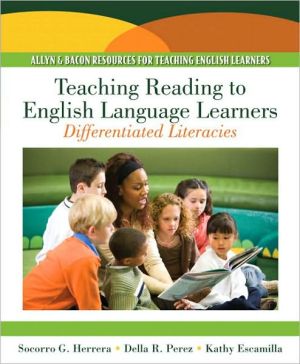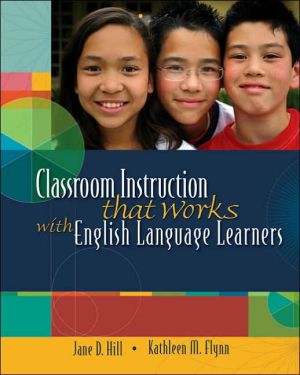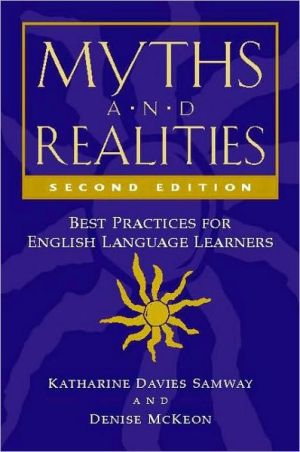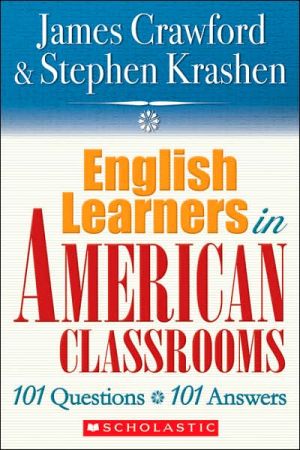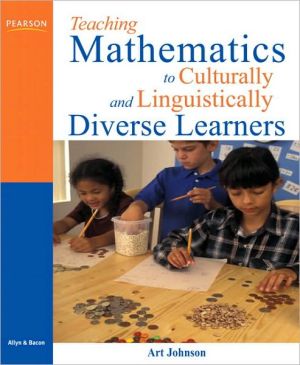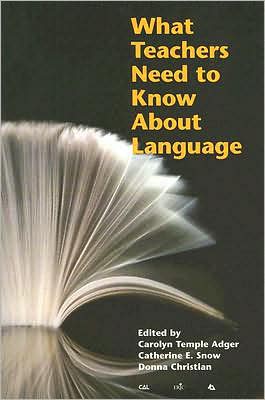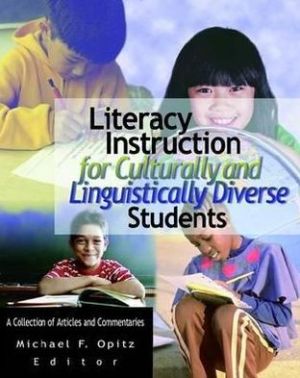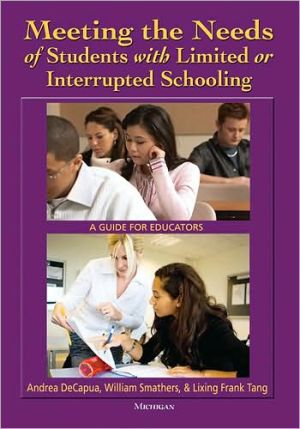Teaching Reading to English Language Learners: Differentiating Literacies
Finally! A new and different guide to creating successful literacy programs for English language learners!\ Teaching Reading to English Language Learners: Differentiated Literacies is a unique text that stresses meaning and relevance as the basis for all instructional activities and strategies for reading and writing instruction to be effective for culturally and linguistically diverse (CLD) students. Respected authors Herrera, Perez and Escamilla argue that if meaning is at the center, it is...
Search in google:
Finally! A new and different guide to creating successful literacy programs for English language learners! Teaching Reading to English Language Learners: Differentiated Literacies is a unique text that stresses meaning and relevance as the basis for all instructional activities and strategies for reading and writing instruction to be effective for culturally and linguistically diverse (CLD) students. Respected authors Herrera, Perez and Escamilla argue that if meaning is at the center, it is not necessary to delay literacy instruction in English while students are learning to understand and speak the language. Practical and research-based, Teaching Reading to English Language Learners: Differentiated Literacies is organized around the major findings from the National Reading Panel Report and addresses a critical national need for teachers to have new and better information on addressing the literacy needs of ELLs. Eloquently, the authors tackle the need to move the field beyond the current ‘one size fits all’ paradigm and toward a broader view of how to create meaningful, relevant, and effective literacy programs for CLD students. Features of the book: Discusses in detail how current techniques and approaches must be modified for ELLs. Strategies in Practice features exemplify the ways teachers can convert research into practical applications for their daily instructional practice with ELL students. Each chapter begins with an outline ofmajor concepts and pedagogy from the viewpoint of ‘best practice’ for monolingual English students. New MyEducationLab created specifically to accompany Teaching Reading to English Language Learners: Differentiated Literacies provides lesson video clips that illustrate content concepts and provide examples of strategies in practice. Student Samples from multiple grade levels and language backgrounds have been included to illustrate the applications of strategies in practice. Teacher Voices are included to highlight teacher insights associated with the accommodation of literacy instruction for ELLs. Includes a brief overview of the approaches to reading instruction for alphabetic languages, and a review of the research findings from two major syntheses of research on literacy—teaching and learning. Outstanding Endorsements for Teaching Reading to English Language Learners: "I think this book is superb. The concepts are appropriately balanced between language acquisition and reading development in the capacity of best practice. The Critical Considerations before the content of the chapters is excellent and develops logically. I like that focus. The classroom scenarios presented throughout the book create an authentic picture of what it is like to have an EL in your classroom." - Cheryl A. Slattery, Shippensburg University "Strategies in action and samples of student work are very positive features of this text — the kinds of features that will make the text accessible to pre- and in-service teachers Games and activities throughout are excellent. Scenarios, Key Theories and Concepts, end-of-chapter questions and other tools are very helpful." - Kimberley Kreicker, Emporia State University
TABLE OF CONTENTS Preface ............................................................................................................................. vi Chapter 1 Language, Literacy, And The CLD Students ..................................... 1 Interactive Literacy: Defining Literacy For CLD Students ............................................. 6 Literacy Is Biographical ........................................................................................ 7 Literacy Is Fundamental ........................................................................................ 9 Literacy Is Research-Based .................................................................................. 10 Essential Elements Of Literacy Development ............................................................... 10 The Theoretical Foundations of Reading ...................................................................... 13 Reading the Symbols and Sounds of English: The Bottom-Up Reading Process Model .................................................................................................................. 13 Literacy Instruction via the Bottom-Up Reading Process Model ....................... 14 Schematic Connections to Text: The Top-Down Reading Process Model .............. 16 Literacy Instruction via the Top-Down Reading Process Model........................ 17 Reading As a Circular Process: The Interactive Reading Process Model ................ 18 Literacy Instruction via the Interactive Reading Process Model......................... 19 Conclusion.................................................................................................................. 20 Chapter 2 Contextualizing Literacy Development For The CLD Student In The Grade-Level Classroom ..................................................................... 27 The CLD Student Biography ....................................................................................... 29 The Sociocultural Dimension ................................................................................. 31 Historical Background Of The Family .............................................................. 32 Literacy Resources ......................................................................................... 34 Perceptions .................................................................................................... 36 The Language Dimension ...................................................................................... 38 Transfer Theory .............................................................................................. 38 Stages Of Second Language Acquisition And CLD Student Literacy Development .................................................................................................. 39 The Academic Dimension ..................................................................................... 40 Prior Schooling ............................................................................................... 41 Academic Policy ............................................................................................. 43 The Cognitive Dimension ...................................................................................... 44 Cognition, Language, And Literacy Development ............................................ 45 Culturally Relevant Texts: Making The Sociocultural Connection....................... 46 Conclusion ................................................................................................................. 47 Chapter 3 Rethinking Phonemic Awareness: A Cross-Linguistic Transfer Perspective .......................................................................................... 58 Phonological Awareness And Cross-Language Transfer .............................................. 61 Phonemic Awareness And Cross-Language Transfer ................................................... 63 Contextualizing Phonemic Awareness Instruction ......................................................... 67 Phonemic Awareness Tasks: Identifying The Subtleties Of The English Language .............................................................................................................. 68 Phoneme Isolation .......................................................................................... 69 Phoneme Identity ............................................................................................ 72 Phoneme Categorization ................................................................................. 73 Phoneme Blending .......................................................................................... 75 Phonemic Segmentation .................................................................................. 77 Phoneme Deletion ........................................................................................... 79 Phoneme Addition .......................................................................................... 80 Phoneme Substitution ...................................................................................... 81 Instructional Guidelines for Phonemic Awareness ................................................... 82 Conclusion ................................................................................................................. 83 Chapter 4 Phonics: More Than The A, B, Cs of Reading .................................. 99 What Comes First: The Letters Or The Words ............................................................ 102 Phonics And Cross-Language Transfer ....................................................................... 103 Contextualizing Phonics Instruction............................................................................... 107 Writing Your Own Script: Creating An Integrated Approach To Phonics Instruction .................................................................................................................. 111 Principle 1: Phonics Knowledge Is Developmental ................................................. 113 Principle 2: Phonics Instruction Is Integrated Into Beginning Reading And Writing Instruction ............................................................................................. 113 Principle 3: Phonics Knowledge Is Important Not For Itself But In Its Application ........................................................................................................ 114 Principle 4: Strategic Knowledge Is Required To Use Phonics Concepts And Skills .......................................................................................................... 114 Principle 5: Phonics Instruction Involves Teacher Decision-Making......................... 114 Principle 6: Peers Teach Each Other Phonics As They Read And Write Side-By-Side .................................................................................................... 115 Integrated Phonics In A Second-Grade Classroom ................................................ 115 Integrated Phonics In A Fourth-Grade Classroom ................................................. 117 Conclusion ................................................................................................................. 119 Chapter 5 Vocabulary Development: A Framework For Differentiated And Explicit Instruction ............................................................................. 149 Implications Of Approaches To Vocabulary Development ........................................... 153 Current Approaches To Vocabulary Instruction ..................................................... 153 Reader-Based Instruction ............................................................................... 154 Interactive Language Learning ......................................................................... 155 Direct Instruction ............................................................................................ 156 Teaching Vocabulary Within A Linguistic And Cultural Context ............................. 157 The Cultural Biography Of The CLD Student: From The Known To The Unknown 158 Sociocultural Dimension ............................................................................ 160 Linguistic Dimension ................................................................................. 161 Preproduction ..................................................................................... 162 Early Production ................................................................................. 162 Speech Emergence ............................................................................. 163 Intermediate Fluency ........................................................................... 163 Advanced Fluency .............................................................................. 164 Academic Dimension ................................................................................ 165 Bridging And Connecting Through Cognates ....................................... 166 Cognitive Dimension ................................................................................. 167 Situating Instruction Based On The CLD Student Biography ................ 168 Vocabulary Selection .................................................................... 169 Before-The-Lesson Strategies: Tapping Into Prior And Background Knowledge To Bridge And Connect ....................... 171 Practicing And Applying Academic Vocabulary ............................. 174 Creating Interactive Learning Environments ................................... 176 Assessing CLD Students’ Acquisition Of English Academic Vocabulary ................................................................................ 178 Conclusion ........................................................................................................... 179 Chapter 6 Strategies-Based Comprehension Instruction: Linking The Known To The Unknown...................................................................................... 195 Comprehension: Constructing Meaning From Text........................................................ 199 Building From The Known To The Unknown ........................................................ 200 Schematic Connections In Practice .................................................................. 201 Putting Reading Comprehension Strategies Into Practice ........................................ 203 Metacognitive Strategies — “Thinking About Our Thinking” .............................. 204 In My Head .............................................................................................. 206 True Or False? ......................................................................................... 206 Sticking To The Main Idea ........................................................................ 207 Question Bookmark ................................................................................. 208 Cognitive Strategies To Promote Reading Comprehension ............................... 208 SEA Box .................................................................................................. 209 Visualize-Interact-Predict (VIP) ................................................................ 209 1, 2, 3 Imagery ......................................................................................... 212 Signature Lines ......................................................................................... 212 Story Retelling .......................................................................................... 213 Social/Affective Comprehension Strategies ...................................................... 215 Critical Questions ..................................................................................... 215 Through My Eyes ..................................................................................... 216 Conclusion ................................................................................................................. 217 Chapter 7 Fluency In Practice: More Than “Reading” The Text ...................... 247 Deep Constructs Of Fluency Development .................................................................. 250 The Multiple Dimensions Of Phonemic Awareness And Phonics ............................ 250 Decoding Through Cross-Language Transfer ................................................... 250 Articulation Of Orthographic Cues .................................................................. 252 Prosidic Elements Of The English Language In Practice ................................... 254 Stressing The Important Sounds In Words ................................................ 254 High Tones And Low Tones Of The English Language .............................. 255 Phrasing And Reading Fluency .................................................................. 256 The Role Of Vocabulary Knowledge .................................................................... 257 Automaticity Through Repeated Reading ......................................................... 258 Comprehension As The Key.................................................................................. 261 Learning Strategies In Practice ........................................................................ 262 Supporting Fluency Development Through Collaboration ............................................. 263 Acting On Fluency: Readers’ Theater For CLD Students ....................................... 264 Choral Reading ..................................................................................................... 266 Repeated Reading ................................................................................................ 268 Sustained Partner Reading .................................................................................... 269 Conclusion.................................................................................................................. 270 Chapter 8 Implications Of Culture And Language In Writing ........................... 283 Differences Between Oral And Written Language Development ................................... 288 Teaching Writing In A Second Language ..................................................................... 289 Discourse Patterns ................................................................................................ 293 Interactive + Direct Approaches To Teaching Writing To CLD Students ................ 294 Getting Started: Beginning Writing ................................................................... 295 Interactive Spelling For CLD Students: From Individual To Cooperative Team ........................................................................................................... 299 Assessing The Writing Of Second Language Learners: Looking For Strengths......................................................................................................... 301 Conclusion ................................................................................................................. 305 Chapter 9 Outside The Lines: Assessment Beyond The Politics Of High Stakes Tests................................................................................ 324 Overtested Without A Foundation ............................................................................... 327 Authentic Assessment Defined .................................................................................... 328 Authentic Reading Assessment (ARA) Within A CLD Context .................................... 329 Socioculturally Speaking ....................................................................................... 330 Language As A Cultural Response ........................................................................ 330 Academic Considerations ..................................................................................... 332 Cognitive Pathways .............................................................................................. 332 Point Of Departure: Preinstructional ARA ................................................................... 333 Thinking, Learning, And Formative Assessment ........................................................... 334 Feedback In Formative Assessment ...................................................................... 334 Questions As Tools In Reading Assessment .......................................................... 336 Putting The Pieces Together: Student Case Studies ...................................................... 338 Yamin: Where Am I? ............................................................................................ 338 So Yeong: Between Two Worlds .......................................................................... 342 Conclusion ................................................................................................................. 347 Chapter 10 Inclusive Literacy Instruction for CLD Students ............................... 361 Setting The Goal: Standards-Driven Literacy Instruction ............................................. 365 The Standards For English Language Arts ............................................................. 365 ESL Standards For Pre-K — 12 ............................................................................ 369 Fidelity And The CLD Learner ................................................................................... 371 Embedding Strategies In Your Existing Curriculum ................................................. 372 Standards — Reading Programs — CLD Student Biography .......................................... 373 Sociocultural Knowledge ...................................................................................... 373 Linguistic Knowledge ............................................................................................ 374 Academic Knowledge .......................................................................................... 375 Cognitive Knowledge ........................................................................................... 376 Conclusion ................................................................................................................. 377 Glossary ..................................................................................................................... 382 References.................................................................................................................. 387
